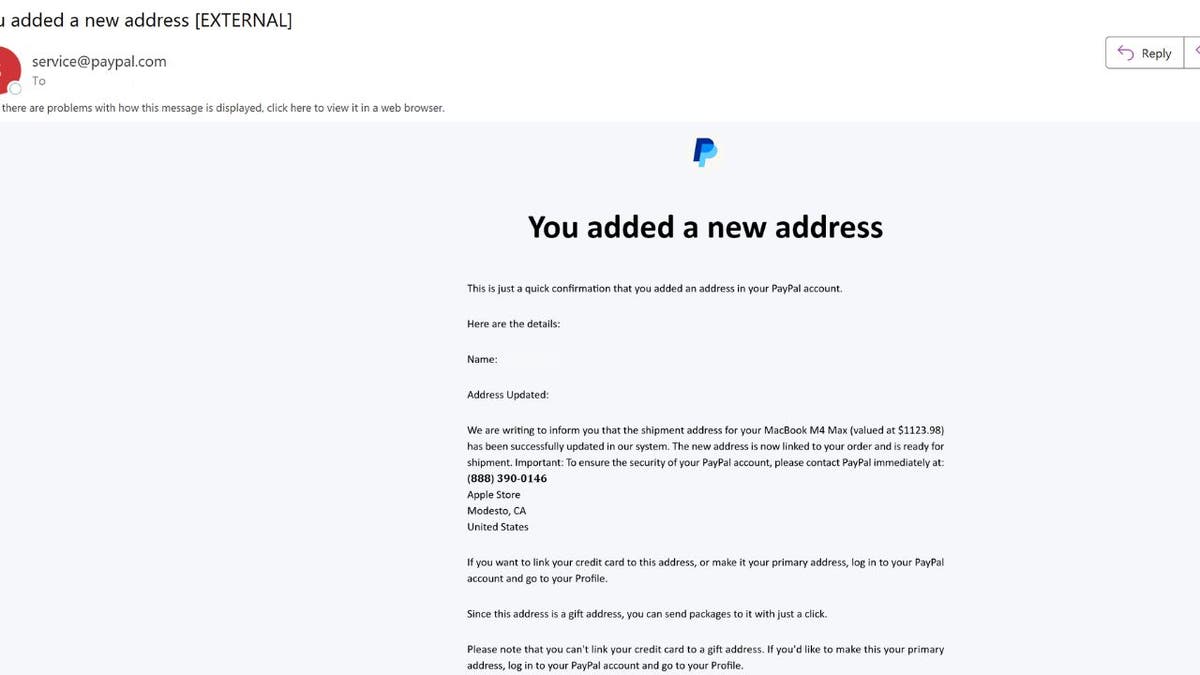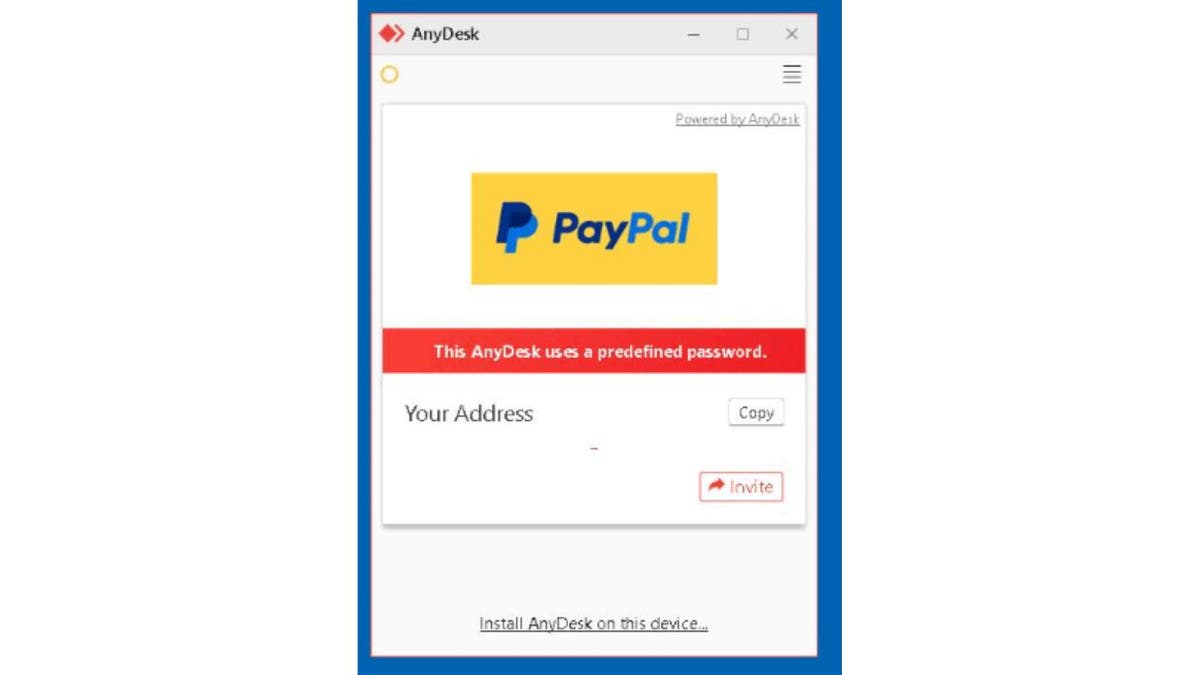New PayPal phishing scam steals your information using legal emails

NewYou can listen to Fox News articles now!
There is a new Paypal phishing scam, which is so convincing that even security-conscious users are attracted. Unlike the typical scam with typos and fake domains, the scam uses PayPal’s own email system to send you an alert that looks 100% true.
You may receive a message like “You added a new address. This is just a quick confirmation you added in your PayPal account.”
Except…you don’t. What to do if you don’t even have a PayPal account? That’s what the scam needs, why it works and how to protect itself.
Sign up for my free online report
Get my best technical tips, emergency security alerts and exclusive deals delivered directly to your inbox. Plus, you’ll be visiting my Ultimate Scam Survival Guide now – Free when you join.
Forged Venmo accounts are stealing donations from real charities
PayPal app on smartphones (Kurt “CyberKnutsson)
Why the latest Paypal phishing scam is so convincing
Most phishing scams try (and fail) to imitate big companies. You may have seen the classic: weird grammar, suspicious email addresses, spelled by Microsoft with “K”. They are ridiculous. However, this scam flips the script because it uses PayPal for you. Here’s how the scam works:
Take advantage of real functions: Scammers abuse PayPal’s “Add Address” or “Currency Request” tool. By typing your emails, they can trigger real emails in PayPal’s real domain. This works even if you don’t have a PayPal account.
Bypass the filter: Since these emails come directly from PayPal’s server ([email protected]), they pass all security checks and appear legitimate in your inbox.
Lack of doubt: Some versions have no phishing links at all, only the phone numbers of the scammers, making them harder to detect.
Panic Bait: The message usually claims to have a new address added, or is processing a large amount of payments, which draws your attention and causes a quick response.
Follow-up attacks: After emailing, the scammer may contact you later, pretending to be PayPal support. You have been urged to click on the link to “protect your account”, which leads to a fake login page designed to steal your credentials.
PayPal’s Dark Side and How to Stay Safe
Real examples of PayPal phishing scams
Dozens of users reported the scam on Reddit and cybersecurity forums. A reddit user Detailed threads have been published exist R/Scam Screenshots of the phishing emails appear to be directly from PayPal’s official address.

Phishing emails are sent from [email protected] (reddit)
In an updated, more complex twist, the scammers are completely deleting the link. Instead, they include a phone number, asking you to call. Once done, you will be in touch with a fake PayPal representative who says they need to verify your identity. They then instruct you to download what appears to be a PayPal branded support tool, but in fact, it is a custom remote access application hosted on other servers. Once installed, it gives scammers full access to your device.

Screenshot of a custom Anydesk app with PayPal logo (reddit)
New phishing scams go beyond security code to steal your information
How scammers hijack PayPal’s system to send false alerts
This part remains a mystery. With a typical PayPal invoice scam, the content is strictly controlled, which means you can’t usually change the email structure or messaging. However, these new emails suggest that scammers may be leveraging internal features such as business tools or API fields to sneak custom content into alerts generated by PayPal. It’s not only phishing, but also weaponizing legitimate systems to build trust and evade detection.
Why is this PayPal phishing attack so dangerous
The scam is particularly effective and dangerous because these emails come directly from PayPal’s official server, making it difficult to distinguish them from legitimate messages. Since the sender’s address and brand are real, the recipient is more likely to trust communication without doubt.
Scammers also use emergency language to create a sense of panic, such as warnings about unauthorized activities or substantial expenses. This pressure encourages people to act quickly and frequently before fully considering whether the alarm is real.
Furthermore, the scam often involves subsequent contacts through calls or texts from individuals impersonating Paypal personnel, further exploiting the initial confusion and increasing the chances of victims to give up sensitive information.
Click here to visit Fox Business

Illustration of a hacker at work (Kurt “CyberKnutsson)
How to protect yourself from Venmo, Zelle and cash app scams that can eliminate your savings in seconds
How to protect yourself from PayPal phishing scams
Even if you stay alert, you can still be a target. Here is how to stay safe:
1. Even if it looks real, don’t click on the links in suspicious emails and use powerful antivirus software. If you receive a PayPal alert you didn’t expect, please access PayPal by typing PayPal.com into your browser or using the official app. Never click on the link or dialing phone number provided in the email.
The best way to protect yourself from installing malware (malicious links that may access private information) is to install antivirus software on all devices. This protection can also remind you about phishing email and ransomware scams, ensuring your personal information and digital assets are secure. The choice of the best 2025 antivirus protection winners for your Windows, Mac, Android and iOS devices.
2. Enable Two-Factor Authentication (2FA): Add to 2FA for you PayPal Even if your password is compromised, it will provide you with a second layer of defense.
3. Using Password Manager: Using a password manager is the best way to ensure that every login you use has a unique strong password. No duplication means that if a site is hacked, there is no chain reaction. Get more details about me Best Expert Review Password Manager for 2025.
4. Manually check your account: If you have questions, just log in to your PayPal account directly. Review Recent Events See if there are any telescopes. No need to rely on alarms alone.
5. Report a scam: forward Suspicious PayPal news to [email protected]. You can, too Report phishing attempts to the FTC.
6. Use personal data deletion services: Since phishing scams like the recent PayPal scams often target scammers collecting personal information from data brokers and people searching for websites, using reputable data deletion services can help you reduce exposure. Check out my preferred data deletion service here.
Get one Free scan Find out if your personal information is already on the Internet.
Kurt’s key points
This phishing scam is dangerous because it uses a real PayPal email sent from [email protected]. Scammers utilizes PayPal’s built-in capabilities to send real notifications that look legitimate. What makes it particularly sneaky is that there are no links, but these emails include a phone number, making them more likely to pass spam filters. When you call, you will connect to the fake PayPal Rep, which forces you to download a remote access tool that disguises as a software-enabled one. The safest move? Don’t click, don’t make phone calls. Just visit Paypal.com directly and check your account manually.
Click here to get the Fox News app
If you’ve seen a version of this scam (or almost fell on it), please write to us by writing cyberguy.com/contact
For more technical tips and security alerts for me, please subscribe to my free online reporting newsletter cyberguy.com/newsletter
Ask Kurt a question or let us know what stories you want us to cover
Follow Kurt on his social channels
Answer the most questioned online gu questions:
New things from Kurt:
Copyright 2025 CyberGuy.com. all rights reserved.

